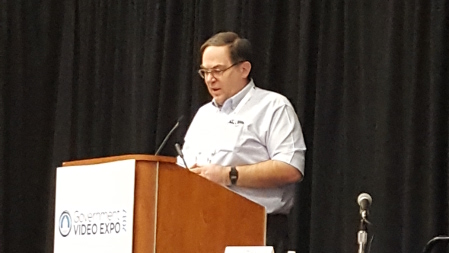GV Expo: Saving Our Audiovisual Heritage for Future Generations
WASHINGTON—The Packard Campus at the Library of Congress’ National Audio-Visual Conservation Center celebrated its 10th anniversary in July, and Government Video Expo attendees learned more about preserving our audiovisual heritage in Wednesday’s session “Content Preservation and the Library of Congress.”

James Snyder, a senior systems administrator at the facility, is very familiar with the task of preserving the world’s most comprehensive collection of films, television programs, radio broadcasts and sound recordings dating back to the 1800s, and he shared what has been learned in the first decade of operation.
The numbers are staggering. The Packard Center currently holds more than 165 billion items. The collection is 80 percent copyrighted content and 20 percent acquired collections. The Motion Picture, Broadcast and Recording Sound Division, which is the copyright depository division for the non-print media division of the Library, holds more than 7 million audio, video, film and software, electronic gaming and education items. Of those 7 million items there are 1.8 million moving image recordings in almost every format; 3.6 million audio recordings of almost every format, 255 million feet of film; paper records regarding the collected content; and increasingly, digital content.
When the Packard Center opened in July 2007, it was the first time the entire collection was housed in one location. Snyder said that the original needs assessment “was a little off. So our 10-year expansion space was actually filled just three years after we opened. We’ve been taking some of our supplies out of the building and sending them to federal warehouses. ... Part of our challenge going into the future is how to handle the fact that we’ve run out of storage space.” He said the nice thing about being in the facility is that it consolidates content from eight warehouses in four states, and staff can finally inventory and catalog with the goal of eventually migrating and making the collection available to researchers, the public and anyone else who would like to see “what is basically the cultural archive of the United States.”
The digitization process began in 2009 with a goal to preserve the content for at least 150 years, which is the legal period for copyright registration. So the content of a file or a tape that arrives today must be maintained for accessibility, searchability and usability until the year 2167.
Snyder said they have learned a lot of lessons in the last 10 years about what it takes to maintain materials, metadata and QC performance just for 10 years in the digital form and it takes a number of things to enable long-term survivability. First is the need to use well-documented, internationally recognized standard file formats. The facility does not use vendor-specific standards because the standard could be changed at some point down the road. Second is the goal of “preserving the content as close to the original quality as is technically feasible. Luckily, with digital, when you’re talking about analog, that’s actually straight forward to do. The simplest part for us has been the digitization. ... The difficult part for us has been in cataloging the metadata and QC reports and the migration of the data set over periods of time,” he said.
Snyder mentioned some of the near-term challenges for the Packard Campus team are film scanning to larger-scale production status; automating many functions currently done manually; and making color corrections, trims and other functions easier on human processes.
Some challenges he sees ahead are finding enough equipment to keep the migration going; growing the Digital Repository into the exabyte realm ... and beyond; developing the knowledge and training needed to ensure future employees on the project are adequately trained; updating workflows and software for new requirements; dealing with how the physical collection continues to age; studying how the digital collection’s physical storage and equipment ages, as well as to study how automated QC functionality is working or not working and adjusting as necessary.
To learn more about the NAVCC Packard Campus, visit the website.
Get the TV Tech Newsletter
The professional video industry's #1 source for news, trends and product and tech information. Sign up below.
